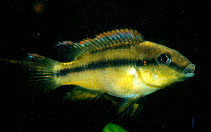| Family: |
Cichlidae (Cichlids), subfamily: Pseudocrenilabrinae |
| Max. size: |
7.7 cm SL (male/unsexed) |
| Environment: |
demersal; freshwater; brackish; pH range: 6; dH range: 5 |
| Distribution: |
Africa: Endemic to the upper tributaries of the Pra basin in Ghana (Ref. 53405). |
| Diagnosis: |
Dorsal spines (total): 15-16; Dorsal soft rays (total): 9-10; Anal spines: 3-3; Anal soft rays: 7-8. Diagnosis: body depth 34.5-35.2% of standard length; interorbital space 24.4-27.8% of head length; 15 or 16 dorsal-fin spines; 23 lateral-line scales (Ref. 53405).
Description: body elongated; snout pointed; frontal profile straight to slightly rounded; males with upper and lower portions of caudal fin with elongated rays, giving it a bifurcated appearance, absent or very poorly developed in females; rays in caudal, anal and pelvic fins also more elongated in males than in females; pelvic fin of female normally slightly rounded (Ref. 52307). Scales cycloid; outer and inner jaw teeth unicuspid, pharyngeal jaw teeth bicuspid; no micro-gillrakers (Ref. 53405).
Coloration: in live: males: back greyish-brown, sides golden-beige, underside bright yellow; rather indistinct band running from snout to anterior part of eye and continuing from postopercle to caudal peduncle, this band being particularly apparent in frightened specimens, which furthermore have a second narrow band of same colour extending from postoccipital region to base of soft part of dorsal fin; opercular area golden-yellow with distinct yellow-edged spot at hind margin; scales on sides of body and pectoral region edged with violet-red; dorsal fin light orange to canary yellow, with dark red fringe and dark orange submarginal band and covered with reddish-violet spots; upper margin of caudal fin dark red, with broad, orange submarginal band which extends unto upper caudal filament; lower caudal-fin margin blackish with white submarginal band extending unto lower caudal filament; central area of caudal fin pale orange or canary yellow, covered with reddish-violet spots; anal fin pale orange anteriorly, pale violet with reddish-violet spots posteriorly; pelvic fins pale orange; pectorals hyaline (Ref. 53405). Females: back brown, sides beige, opercular and pectoral regions golden yellow; brown mid-lateral band, darker than in males, extending from snout to anterior part of eye and from posterior margin of gill cover to caudal-fin base; belly with bright red area; dark, yellow-edged spot on upper part of opercle; dorsal fin with bright red fringe and narrow, yellow submarginal band; spinous part of dorsal fin copper-red, soft part hyaline; upper margin of caudal fin bright red with broad, copper-red submarginal band extending unto 1/4 of fin (in large individuals), rest of caudal fin yellow-orange; anal and pelvic fins yellow, with bluish-black fringe; pectorals hyaline (Ref. 53405). |
| Biology: |
Only found in small, shallow and well-shaded forested creeks with flowing waters; diet consists primarily of detritus and algae, and to a lesser degree shrimp eggs; pair-bonding cave spawner; facultative, larvophilic mouthbrooder (Ref. 52307). Maximum TL was recorded at 10.0 cm (Ref. 5657). |
| IUCN Red List Status: |
Endangered (EN); Date assessed: 16 April 2020 (B1ab(i,iii)) Ref. (130435)
|
| Threat to humans: |
harmless |
Source and more info: www.fishbase.org. For personal, classroom, and other internal use only. Not for publication.

